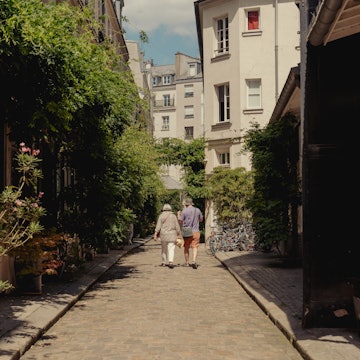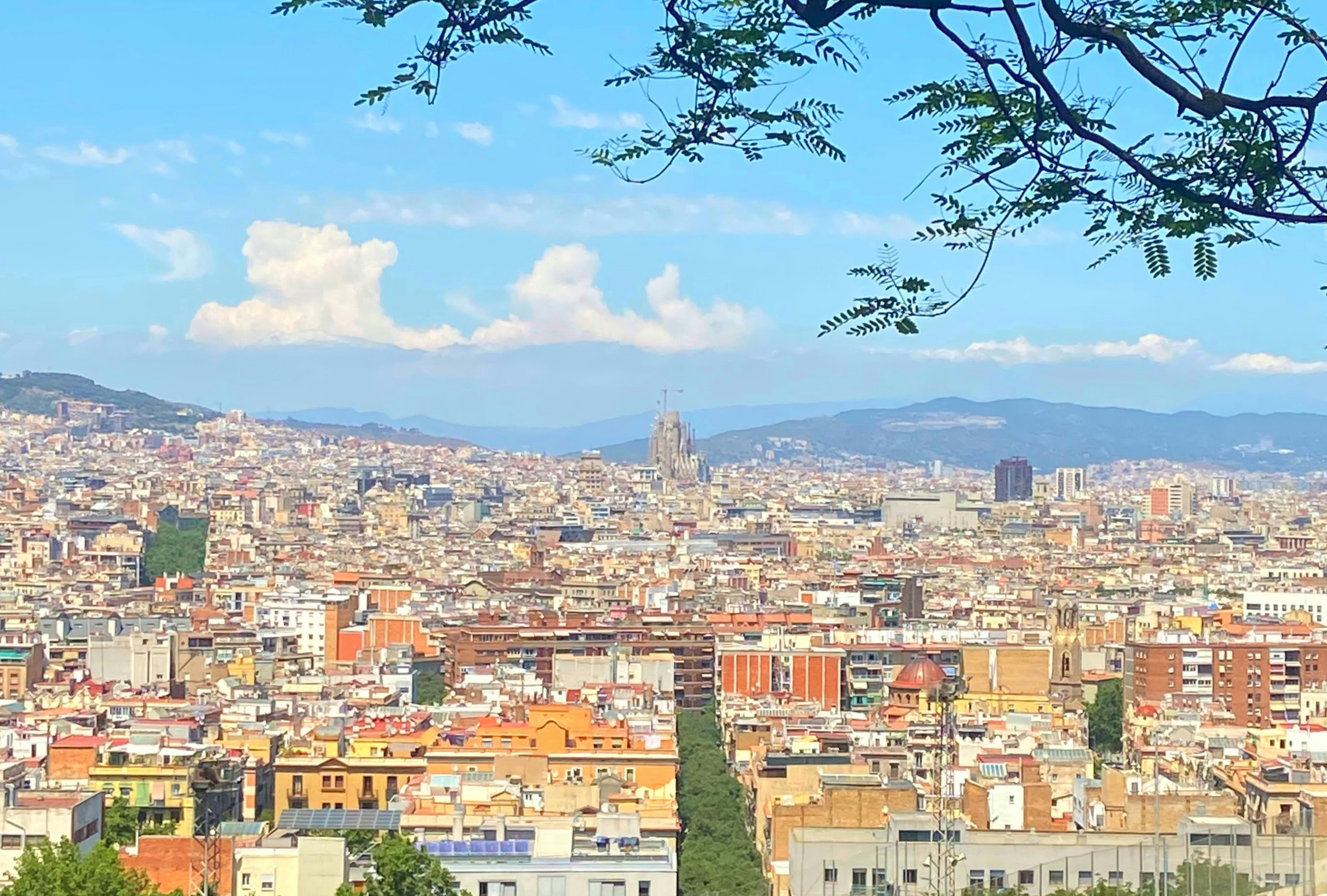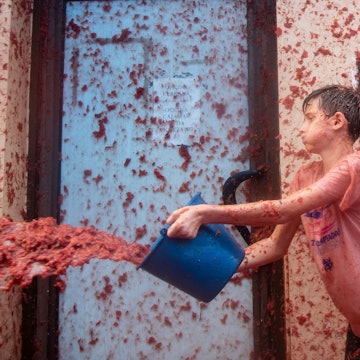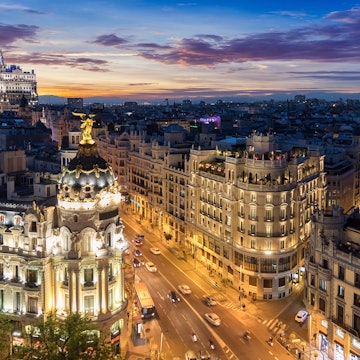

Barcelona's El Born neighborhood is a great area to base yourself in © Getty Images
I jump at any chance to visit Barcelona, whether it's for a music festival like Primavera, catching up with friends, or enjoying a solo, where I can relax on the sunny terrace of a tiny bar, people-watching over an ice-cold glass of vermouth and a plate of salty little snacks. That's one of my favorite activities anywhere, but it holds a special charm in Barcelona, where life is lived on the plazas, side streets and terraces.
When to visit: Offseason. It's sunny, the sea is still warm-ish, there are fewer crowds and it's much easier to navigate.
How to get from the airport: The airport metro takes you directly from El Prat to any of the main central metro stations for €5.50. You can also get the airport shuttle bus for €2.40 to the city's center. It stops at Plaça de Catalunya, which has excellent city-wide connecting transport options.
Getting around town: You can quickly get from one part of the city to the next on the metro. If you're staying for a long weekend, the best value is the T-Casual card (10 metro rides in zone 1) for €12.15. Or, try the Hola Barcelona Card, which offers unlimited travel on the metro, bus, tram, funicular and airport transport for €25.50 for three days. Uber hasn't really taken off here, so download the Cabify app instead. I find Barcelona is best explored on foot, though, and you get to admire all the gorgeous architecture you'd otherwise miss if you were traveling in a car or underground on the metro.
Where to stay: My favorite neighborhood is Gràcia for the sunny squares, late-night salsa clubs and old independent boutiques. But if you're staying for a short time and want to be in the center of the action, I'd go with El Born. It's home to museums, tiny hotels, great restaurants and it's close to the beach. It's in the Old Town but removed from the raucousness of the Gothic Quarter. I also really like Eixample, it's quite touristy but really elegant and where you'll find Gaudí attractions like Casa Batlló and La Sagrada Família.

Friday
Morning
Drop your bags off at your hotel in El Born and head straight to Mercat de Santa Caterina for a sticky tortilla at Bar Joan. While most visitors go to La Boqueria to jostle elbows with hordes of other tourists, Santa Caterina feels more like a local market where longtime residents shop for groceries. Afterward, chill by the lake in Parc de la Ciutadella or stroll towards Barceloneta Beach along Carrer de Circumval·lació, where food and crafts market stalls are set up along the street.
How to spend the day
Back in El Born, visit the Museum of Contemporary Art (Moco) to see works by Jean-Michel Basquiat, David LaChapelle and Salvador Dalí (I love the Yayoi Kusama mirror room because it feels very trippy, like floating in space). Continue to the Picasso Museum on the same street. The museum, occupying five medieval palaces, is an homage to Picasso's formative years, which were spent in Barcelona. Back outside, decompress with a coffee at nearby Xiloteca or, make like Picasso and head to the Art Nouveau-style cafe, Els Quatre Gats, a famous meeting point for artists during the Modernist era.
Dinner
If I lived in Barcelona, I'd eat at Bar del Pla every week. Their small, perfectly crafted tapas menu focuses on quality ingredients, and the wine list is superb. Try the oxtail brioche and picanya roast beef and definitely order the patatas bravas (potatoes in a spicy tomato sauce) because they are, hands down, the best in the city. Don’t let the casual vibe fool you into thinking you don’t need to book ahead. It's always busy.
After dark
Wind your way through the narrow alleys of El Born to find Dr Stravinsky, where the award-winning cocktails are elevated to an art form. The bartenders are always flipping, shaking and making dramatic pours like Tom Cruise in Cocktail, and while that sounds cheesy, they make it look good. I love the theater of it all.
First time in Barcelona? Here are the things you should know

Saturday
Morning
Start with coffee at Espai Mescladis, a cafe that trains and employs refugees and helps them build ties within the neighborhood. It has a really lovely community vibe. Most of the produce is organic, fair trade, and produced locally. It's a great place to eat solo, with shared tables in the airy courtyard.
How to spend the day
Open-top bus tours are perfect for exploring Barcelona, a city where the architecture is so distinctive that it feels like an open-air museum. Consider the City Sightseeing bus (starting from €33.00) and begin with the blue line to discover the top Modernista landmarks and Camp Nou. Switch to the red line at Diagonal (Francesc Macià stop) to access Montjuïc, where you can explore the Museu Nacional d’Art de Catalunya in the 1920s Palau Nacional and the Fundació Joan Miró.
My "secret" tip
Before rejoining the bus tour at the Telefèric de Montjuïc stop, take a short walk to Bar Marcelino, a cheap and cheerful outdoor bar surrounded by trees off the main route that's popular with locals. Not many tourists seem to know it's here, but it offers some of the best panoramic views of Barcelona.
Dinner
Bar Cañete in La Raval is a real treat, offering a fusion of Catalan, Andalusian, and French cuisine with white-tablecloth service. The staff treat everyone like they've been coming here for years. It's expensive, but you can keep the costs down by ordering a mix of appetizers like lobster croquetas and fried artichokes. You'll need to book far in advance but if you miss out and want a similar upscale tapas experience, go to Gresca in Eixample. I love it and so does Dua Lipa.
After dark
If you're in the mood for dancing but haven't secured tickets for the major clubs in advance, try your luck at Monk, a "secret" bar and club in El Born. The hidden entrance to its cocktail bar can be found at the back of a grocery store on Carrer Dels Abaixadors (behind the Haribo stand), along with another covert entryway leading to the club itself. For a unique Barcelona outing, venture to Poble Espanyol, an open-air architectural museum hosting DJs and live music. For a more relaxed evening, check out the musical program at Palau de la Música Catalana. Look out for its dazzling, stained-glass skylight.
Don't miss Barcelona's best experiences

Sunday
Morning
Many Barcelona restaurants are usually closed on Sunday or Sunday/Monday, limiting your options. But there are still treats to be had if you know where to look. I love Soma in Eixample for a late breakfast. Book ahead and request a seat on the terrace. Many of the streets around Eixample are pedestrianized on Sundays so you can enjoy a lovely little morning walk afterward.
How to spend the day
Many shops also close on Sundays, so it's a good day to get out and explore the city's museums. To avoid the Sunday crowds at popular attractions like La Sagrada Família, consider visiting Casa Vicens instead, a less-visited Gaudí museum.
Once you've soaked in some architectural marvels, shift gears to the Gràcia neighborhood for coffee and lunch at Bar La Camila, a gorgeous mid-century styled café that also serves Catalan dishes like calçots (chargrilled green onions with romesco sauce) and esqueixada (salt cod salad). Top the afternoon off with vegan ice cream at Amma Gelato and enjoy it at Plaça de la Virreina, a square surrounded by bars and restaurants where residents gather to savor their Sundays.
Dinner
You can get Gildas (a briny and tangy appetizer featuring a fat olive, salty anchovy and pickled Guindilla pepper) at pretty much every bar in Barcelona, but the ones served at Bar Salvatge in Gràcia are top-tier. This space is rightly famous for its fun and delicious small plates and geeky natural wine menu. It's also a great place to spend the night because the music is loud, and it stays open until 12:30am.
After dark
La Pedrera is the name given to Casa Milà, Gaudí's apartment block. You can visit at any time, but I highly recommend booking a nighttime tour. In winter they run from 7pm and in summer from 9pm. Tickets (from €39 for adults) include a glass of Cava, a music show on the rooftop (featuring a variety of genres from jazz to rumba) and a guided tour.

Monday
Morning
Wake up early and join the queue for Milk Bar & Bistro, the pioneer of brunch in Barcelona. While the food is excellent, I find the constant queues daunting. If you're willing to wait, try the chorizo hash or the matcha pancakes — both are delicious. For shorter waits in the Old Town, consider Cafe del Born or, for a lighter option, Flax and Kale. To cap off your time in Barcelona, celebrate with vermouth (vermouth hour starts at noon): visit Bodega Fermín, a classic bar in nearby Barceloneta where the house-made vermouth is served straight from the barrel.
How to spend the day
Shop for unique pieces in places special to Barcelona. Begin at Cereria Subirà in El Born, the city's oldest candle shop (it's been around since 1761) where you'll find candles in all sorts of shapes, colors and scents. Then, wander down to La Manual Alpargatera in the Gothic Quarter for handmade espadrilles and La Clinique for vintage designer sunglasses and exclusive perfumes. I always like to pick up a book in the local language when I'm visiting a city, even if I can't speak it. In Barcelona, I recommend Lliberia Calders in Sant Antoni for a diverse selection of Catalan books, followed by a visit to Café Cometa for an iced-coffee.
Dinner
Stick around in Sant Antoni and have dinner at local staple Bar Bodega Gol, where you probably won't see another tourist. It's an unpretentious spot where the walls are lined with wine barrels, and the simple menu showcases the quality of ingredients from across Spain, particularly Galicia. Try the escalivada (roasted vegetables), botifarra (Catalan sausage) or Galician beef. It closes early on a Monday (4.30pm) so if that's too tight for you, try nearby Bandini's a restaurant offering Mediterranean dishes with a Scandinavian twist.
















